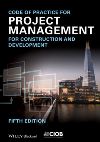Code of practice for project management Fifth edition
NB In May 2022, CIOB published a 6th edition of the code of practice. For more information see: Sixth edition of the Code of Practice for Project Management.
In 1991 the Chartered Institute of Building (CIOB) initiated a multi-institute task force which published the Code of Practice for Project Management for Construction and Development in 1992. It set out for the first time a comprehensive specification for the role of project manager.
The second edition, published in 1996, included new information about public procurement, partnering and risk. Changes included in the third edition, published in 2002, reflected the core stages of the project management processes and the fourth edition, published in 2010, absorbed a range of new themes emerging in the industry.
The 5th Edition, published in September 2014 was completely overhauled to make it more contemporary and was updated and restructured to reflect the new challenges face by the industry. It was prepared in collaboration with a number of key professional bodies.
According to CIOB, good project management relies on balancing time, quality and cost in relation to building functionality and requirements for sustainability. The principles of strategic planning, detailed programming and monitoring, resource allocation and effective risk management, are covered by the guide. The integration of Building Information Modelling (BIM) is also featured. In addition, the impact of trends and developments such as the internationalisation of construction projects and the drive for sustainability are discussed.
Chris Blythe, CIOB chief executive said; “I am pleased to see that the 5th edition of this document is being published at a time where the built environment is gathering great momentum, with a number of high profile projects as well as the resurgence of the housing sector, where construction project management, as a professional service and discipline, is at the forefront of ensuring delivery management.
“The Code of Practice will retain its position as the primary source of guidance on the principles and practice of construction project management irrespective of the size, nature or complexity of the project.”
David Woolven, Chair of the CIOB Working Group said, “This publication is a result of many hours of debate, discussion and re-drafting and a lot of effort has gone into the information contained within this edition. The result I believe has been a truly impressive and highly authoritative guide to the current practice of construction project management, for those who are either involved or likely to be involved in managing projects, irrespective of their previous experience and knowledge in built environment.”
Table of contents:
- Introduction.
- Inception.
- Feasibility.
- Strategy.
- Pre-construction.
- Construction.
- Testing and commissioning.
- Completion, handover and operation.
- Post-completion review and in use.
- Glossary.
- Bibliography.
NB: On 26 September 2016, CIOB launched its first Code of Practice for Programme Management. Programme management is the process of managing several related projects, often with the intention of improving an organisation’s performance. The code sets out the requirements for effective programme management, ensuring systematic quality control and documentation through governance arrangements and explains the benefits of managing a number of connected projects as a programme.
--CIOB
[edit] Related articles on Designing Buildings
- A solution to handle large and complex construction projects: Interface Management.
- Association for Project Management APM
- Business administration.
- Code of practice for programme management.
- CIOB.
- Conflict of interest.
- Design management.
- Microsoft's six ways to supercharge project management.
- Monte Carlo simulation.
- Preliminary business case.
- Project execution plan.
- Projectisation.
- Project management.
- Risk management.
- Sixth edition of the Code of Practice for Project Management.
- Value management.
Featured articles and news
International Electrician Day, 10 June 2025
Celebrating the role of electrical engineers from André-Marie Amperè, today and for the future.
New guide for clients launched at Houses of Parliament
'There has never been a more important time for clients to step up and ...ask the right questions'
The impact of recycled slate tiles
Innovation across the decades.
EPC changes for existing buildings
Changes and their context as the new RdSAP methodology comes into use from 15 June.
Skills England publishes Sector skills needs assessments
Priority areas relating to the built environment highlighted and described in brief.
BSRIA HVAC Market Watch - May 2025 Edition
Heat Pump Market Outlook: Policy, Performance & Refrigerant Trends for 2025–2028.
Committing to EDI in construction with CIOB
Built Environment professional bodies deepen commitment to EDI with two new signatories: CIAT and CICES.
Government Grenfell progress report at a glance
Line by line recomendation overview, with links to more details.
An engaging and lively review of his professional life.
Sustainable heating for listed buildings
A problem that needs to be approached intelligently.
50th Golden anniversary ECA Edmundson apprentice award
Deadline for entries has been extended to Friday 27 June, so don't miss out!
CIAT at the London Festival of Architecture
Designing for Everyone: Breaking Barriers in Inclusive Architecture.
Mixed reactions to apprenticeship and skills reform 2025
A 'welcome shift' for some and a 'backwards step' for others.
Licensing construction in the UK
As the latest report and proposal to licence builders reaches Parliament.
Building Safety Alliance golden thread guidance
Extensive excel checklist of information with guidance document freely accessible.
Fair Payment Code and other payment initiatives
For fair and late payments, need to work together to add value.
Pre-planning delivery programmes and delay penalties
Proposed for housebuilders in government reform: Speeding Up Build Out.
High street health: converting a building for healthcare uses
The benefits of health centres acting as new anchor sites in the high street.


























